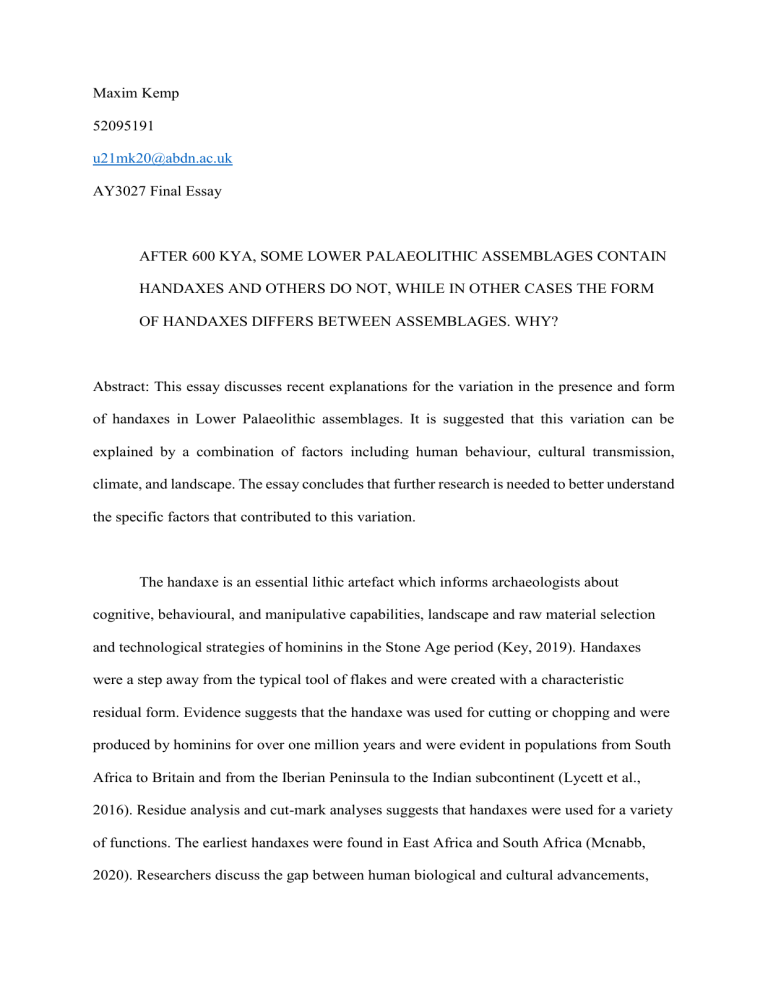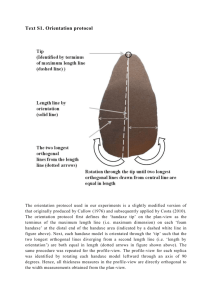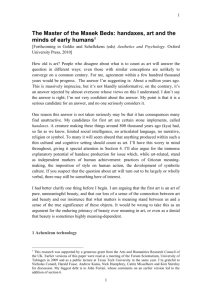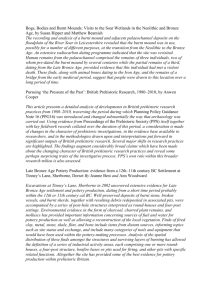
Maxim Kemp 52095191 u21mk20@abdn.ac.uk AY3027 Final Essay AFTER 600 KYA, SOME LOWER PALAEOLITHIC ASSEMBLAGES CONTAIN HANDAXES AND OTHERS DO NOT, WHILE IN OTHER CASES THE FORM OF HANDAXES DIFFERS BETWEEN ASSEMBLAGES. WHY? Abstract: This essay discusses recent explanations for the variation in the presence and form of handaxes in Lower Palaeolithic assemblages. It is suggested that this variation can be explained by a combination of factors including human behaviour, cultural transmission, climate, and landscape. The essay concludes that further research is needed to better understand the specific factors that contributed to this variation. The handaxe is an essential lithic artefact which informs archaeologists about cognitive, behavioural, and manipulative capabilities, landscape and raw material selection and technological strategies of hominins in the Stone Age period (Key, 2019). Handaxes were a step away from the typical tool of flakes and were created with a characteristic residual form. Evidence suggests that the handaxe was used for cutting or chopping and were produced by hominins for over one million years and were evident in populations from South Africa to Britain and from the Iberian Peninsula to the Indian subcontinent (Lycett et al., 2016). Residue analysis and cut-mark analyses suggests that handaxes were used for a variety of functions. The earliest handaxes were found in East Africa and South Africa (Mcnabb, 2020). Researchers discuss the gap between human biological and cultural advancements, whilst the handaxe remained a constant (Finkel & Barkai, 2018). The variety in shape and size of the handaxe, for example, ‘pointed’. ‘twisted’ or ‘ovate’, as well as the similarities in these artefacts, has been described by Isaac (1977) as “variable sameness” (Key, 2019). The presence, as well as the absence of handaxes in archaeological assemblages, offers insight into hominin behaviour. The consistency of handaxe production allows for comparative research within archaeology. Originally, handaxes were considered by archaeologists to be simply cultural objects and that social behaviours were passed down. Cultural transmission may explain how over time handaxes became smaller and thinner (Corby et al., 2016). Conflicting theory however, suggests that there is not sufficient data to determine whether cultural transmission, or, individual learning and genetic transmission offers the best explanation for the history of the handaxe (Corby et al., 2016). There is also a theory that handaxes may have had social importance, for example in negotiating relationships (Davis & Ashton, 2019). Whilst theorists discuss how and why this tool was passed down through this period, the current thinking on why handaxes are present in some Lower Palaeolithic assemblages and not in others, as well as the variation in their form, offers interesting discussion into life in this period. By comparing, measuring and assessing patterns of variations within assemblages, much can be learned about cultural evolution at this time. This essay will discuss current thought on the observance/non-observance/variations of handaxes in archaeological assemblages, and how more research is needed to better understand the specific factors that contributed to handaxe variation. The presence, absence, and variation of handaxes in Lower Palaeolithic assemblages offers insight into hominin behaviour and the cultural evolution of early human populations. While some theories suggest that cultural transmission and social importance may have influenced the development and variation of handaxes, further research is needed to fully understand the specific factors that contributed to these changes. According to Davis and Ashton (2019), landscape setting and climate may have some influence on groups coming into territories. When landscapes remain stable, populations may have remained in place for some time, and not interacted very much with other populations. By remaining in situ, that human group may have developed its own particular traditions and working patterns in tune with the landscape. This in turn would have led to ‘niche construction’ which would have led to structuring of the landscape and reinforcement of the original use of habitat, thus affecting humans and the behaviour of large mammals. If humans were to survive in the landscape, they would need to be able to adapt to the changing climate. In warmer climates, where caves were available for shelter during warm summers and cooler winters, more evidence of longterm habituation is present. In more challenging climates, humans would have moved to a more suitable climate. According to Davis and Ashton (2019), different groups moved into Britain most probably due to climate variations. The authors discuss significant sites of environmental evidence of handaxes and describe how their appearance in various areas may indicate some form of ‘niche’ manufacturing continuity through social learning. For example, distinctive twisted handaxes were discovered in various regions across Britain, despite the fact groups would have moved out of Britain due to intolerable climate. Davis and Ashton (2019) posit that this suggests a material culture of local human groups spanning many millennia. The presence of the handaxe also speaks of the availability in the area of raw material within the territory. How sophisticated the manufacture of the handaxe is, and the lengths the groups travelled to source the materials, may offer information about the brain size and how large the groups were. The mere concept of transporting materials to a new place to then crafting a tool, shows distinct evolution from the previous groups that used and discarded rock tools after use. The shape of the handaxe may also be culturally significant and offer knowledge about hominin social networks and settlement (White et al., 2017). Twisted handaxes may even reveal brain laterality among the group, with 94 per cent of them displaying z-twists instead of s-twists (White et al., 2017). Interestingly, it is reported that the twisted handaxe is very rare, with most appearing in Britain and nearby France (White et al., 2017). The variation of handaxes seen may be explained by the fact that they were made by people of different ages, with some perhaps being more skilled than others. Also the materials used would be different therefore creating a varied piece. However, the twisted handaxes have distinctive forms with clear modal tendencies (White et al., 2017). In the Boxgrove sight in the U.K., handaxes were discovered which were very similar, suggesting that a single community of hominins made the handaxes, and paid attention to creating familiar patterns (Coolidge & Overmann, 2019). The attention to detail in the design of handaxes is of interest to cognitive archaeologists, who attempt to explain archaeological artifacts through cognitive and psychological models. Normativity, or the way in society people do things, make things and say things on a societal level, is also of interest to researchers. Handaxe types may show an early expression of normativity among hominin populations (Shipton & White, 2020). The distinctive shapes given to handaxes, which was then reproduced, suggests that the Acheuleans were able to mentalise their world (Mcnabb, 2020). Recent research suggests that the variation in the presence and form of handaxes in Lower Palaeolithic assemblages can be explained by a combination of factors, including differences in climate and landscape, human behaviour and cultural transmission, and individual learning and genetic transmission. The stability and availability of resources, as well as the climate and landscape, may have influenced the development of different cultural traditions and working patterns among different populations, leading to variation in the form and presence of handaxes. Additionally, the social importance of handaxes and the role they played in negotiating relationships may also have contributed to the variation in their form and presence in different assemblages. The shape and design of handaxes may also provide insight into cognitive abilities and social networks among early human populations. Thanks to ever-advancing methods, archaeologists can follow a chronological framework to decipher environmental remains, allowing for solid dating and reconstruction of human habitats. Britain, in particular, has a good record in this domain. One region in Britain where there have not been any handaxes found is Clacton, which gave rise to the term ‘Clactonian’ to describe a population among which handaxes were obsolete. It is thought that these people may have come from central Europe where there were none or few handaxes. It is assumed that these populations may have been less developed in their technological capabilities. However, there is evidence of simple core and flake tools made from animal bone in the Clacton site. This discovery suggests that this group of people were using available raw materials to create tools. It is thought that the non-handaxe populations were more primitive, hence the absence of this sophisticated tool. However, Parfitt et al. (2022) posit that determining levels of intelligence by tool development alone may not be justified. One artefact from the Clacton site is the Clacton spear. The design of this spear suggests it was used for close hunting (Ashton, 2016). Another site without handaxes is the ‘Southfleet Road Elephant Butchery Site’ which contains simple tools associated with a large elephant. However, several researchers claim that variations in raw materials and sample size was the reason behind their absence (Ashton et al., 2016). For example, fieldwork in East Farm Barnham in the U.K. digs show evidence of similar groups of hominins using the basin over a period of time until the basin ran dry. It is suggested that there may have been handaxe manufacturing when required and if permitted by availability of raw materials (Ashton et al., 2016). However, the argument for raw material shortage is questionable as one U.K. site in Swanscombe, held many thousands of artefacts with evidence of raw materials, but did not reveal any handaxes (Ashton et al., 2016). Clactonians were eventually replaced by Acheulean populations – (named after St Acheul in northern France were the tools were first formally recognised), handaxe producers, who are recorded as arriving at a time of environmental challenges, perhaps even being affected by sea-level changes (White et al., 2017). Again, in Barnham, the handaxe technology would appear to have suddenly arrived with new groups, as opposed to developing over time with a particular group inhabiting the territory. The non-existence and then existence of handaxes, informs research about movement of populations within territories as it signifies diverse cultural behaviour. It also backs up theories that suggest there was a land-bridge between Europe and Britain during this period over which the new population may have traversed. The presence and absence of handaxes can therefore provide insight into the movement and behaviour of early human populations in different territories. In conclusion, the absence of handaxes in some Lower Palaeolithic assemblages, such as at the Clacton and Southfleet Road Elephant Butchery sites, may be due to a variety of factors, including differences in technological capabilities and access to raw materials. Additionally, it can be inferred that differences in climate and landscape would have had a significant impact on the presence and form of handaxes. In stable landscapes, with abundant resources and a favourable climate, populations may have remained in situ for substantial periods of time, developing their own cultural traditions and working patterns that were adapted to the local environment. This could have led to the development of distinct forms of handaxes that were well-suited to the specific needs and resources of the population. In contrast, in more challenging climates and landscapes, populations may have been more mobile and adapted to a wider range of environments, leading to less consistency in the form of handaxes, and a higher frequency of different variants of handaxes. Additionally, the availability of raw materials for the production of handaxes may have been influenced by the local climate and landscape, potentially affecting their presence and form in different regions. For example, in the Middle Pleistocene of Britain, handaxes were typically composed of flint (Davis & Ashton, 2019). Flint is not found in all regions of Britain, thus the composition of handaxes can provide clues about particular handaxe origins, and the transport and migration of early human populations. Some researchers claim that the handaxe remained a pivotal part of Acheulean technology without any major advancement due to preferred cultural conservatism which may have resulted in the long and successful survival of Lower Palaeolithic populations (Finkel & Barkai, 2016). Whilst technological advancement may have occurred, the handaxe remained a fixed tool, described by McNabb and Cole (2015) as existing with ‘variable equilibrium’, showing variation within extended periods of stagnation (Finkel & Barkai, 2016). Finkel and Barkai (2016) suggest that this phenomenon could be explained by psychological bias towards majority imitation leading eventually to the handaxe being a traditional object. There is also thought that the design of some handaxes are too sophisticated to simply have been learned by imitating others and therefore there may have been some teaching of the skill. Researchers argue that perhaps that the handaxe was also used to demonstrate male cognitive and physical skills thus attracting females and playing a role in gene exchange. Long-term success of Lower Palaeolithic populations may be partly explained by a preference for cultural conservatism, which may have led to the handaxe remaining a central part of Acheulean technology without significant advancement. Whilst the study of handaxes can provide important information about hominins in this period, it has been suggested that looking at individual artefacts may restrict the view of the whole picture (Key & Gowlett, 2022). Key and Gowlett (2022) suggest that looking at the wide range of tools used by the population may offer important clues. They argue that “assemblage-level analyses highlight standardisation in form, and deviation therefrom, while individual lithic objects to not”. Nonetheless, researchers will continue to gain extensive knowledge about the movements and characteristics of hominins by studying this important artefact. By considering the broader range of tools and the cultural and environmental factors that may have influenced their use, researchers can gain a more comprehensive understanding of the movements and characteristics of early human populations. In summary, research points to the handaxe being an essential working tool for hominins in the Lower Palaeolithic period, used for butchery and woodworking. It also may have had a social meaning, being passed through the groups for over one million years, acting as a steady method of adaptation, and becoming fixed feature of this society. The variations in detail and design of the handaxes can be explained by the skill set of the individual making the handaxe, and by the availability of the raw materials needed. Absence of the handaxes, referred to as Clactonian, could be due to the hominins being primitive, or, due to lack or shortage of raw materials to make them, or the lack of need at that time for such a tool. The presence of handaxes in archaeological assemblages provides information to researchers on the potential brain size of the hominins, the availability of raw materials in the area they moved from and gives clues to the social behaviour of the groups. The technical designs of the handaxes suggests some formal teaching, and that the tool may be revered as a social symbol suggesting brains and strength. The variation in the presence and form of handaxes in Lower Palaeolithic assemblages can be attributed to a complex interplay of factors, including differences in climate and landscape, human behaviour and cultural transmission, and individual learning and genetic transmission. While much has been learned about cultural evolution through the study of handaxes, more research is needed to better understand the specific factors that contributed to this variation and the significance of handaxes in the lives of early humans. It is likely that the change in shape of the handaxe over time can be attributed to a variety of factors, including changes in the environment and the availability of raw materials, as well as cultural transmission and individual learning. The stability and availability of resources, as well as the climate and landscape, may have influenced the development of different cultural traditions and working patterns among different populations, leading to variation in the form of handaxes. Additionally, the social importance of handaxes and the role they played in negotiating relationships may also have contributed to changes in their form over time. Although there is a plethora of theories and lines of thought regarding this topic, further research is needed to better understand the specific factors that contributed to changes in the shape of the handaxe. Such research could allow researchers to gain valuable insight into the behaviour and social networks of early humans during the Palaeolithic era. Additionally, a better understanding of the factors that contribute to the shape of the handaxe would help archaeologists to more accurately date and classify handaxe assemblages. This would be of considerable benefit to the field of archaeological research within the Lower Palaeolithic time. References Ashton, N., Lewis, S. G., Parfitt, S. A., Davis, R. J., & Stringer, C.. (2016). Handaxe and non-handaxe assemblages during Marine Isotope Stage 11 in northern Europe: recent investigations at Barnham, Suffolk, UK. Journal of Quaternary Science, 31(8), e2918. Ashton, N., Lewis, S. G., Parfitt, S. A., Davis, R. J., & Stringer, C.. (2016). Handaxe and non-handaxe assemblages during Marine Isotope Stage 11 in northern Europe: recent investigations at Barnham, Suffolk, UK. Journal of Quaternary Science, 31(8), e2918. Corbey, R., Jagich, A., Vaesen, K., & Collard, M. (2016). The Acheulean handaxe: More like a bird's song than a beatles' tune?. Evolutionary anthropology, 25(1), 6–19. Finkel, M., & Barkai, R. (2018). The Acheulean Handaxe Technological Persistence: A Case of Preferred Cultural Conservatism? Proceedings of the Prehistoric Society, 84, 1-19. Alastair J.M. Key, Handaxe shape variation in a relative context, Comptes Rendus Palevol, Volume 18, Issue 5, 2019, Pages 555-567, ISSN 1631-0683, Alastair Key & John A. J. Gowlett (2022) Intercomparison of Form, Size and Allometry in a Million-year-old and Modern Replicated Handaxe Set, Lithic Technology Stephen J. Lycett, Kerstin Schillinger, Metin I. Eren, Noreen von Cramon-Taubadel, Alex Mesoudi, Factors affecting Acheulean handaxe variation: Experimental insights, microevolutionary processes, and macroevolutionary outcomes, Quaternary International, Volume 411, Part B,2016, Pages 386-401, ISSN 1040-6182, Parfitt, S.A., Lewis, M.D. & Bello, S.M. Taphonomic and technological analyses of Lower Palaeolithic bone tools from Clacton-on-Sea, UK. Sci Rep 12, 20222 (2022).







